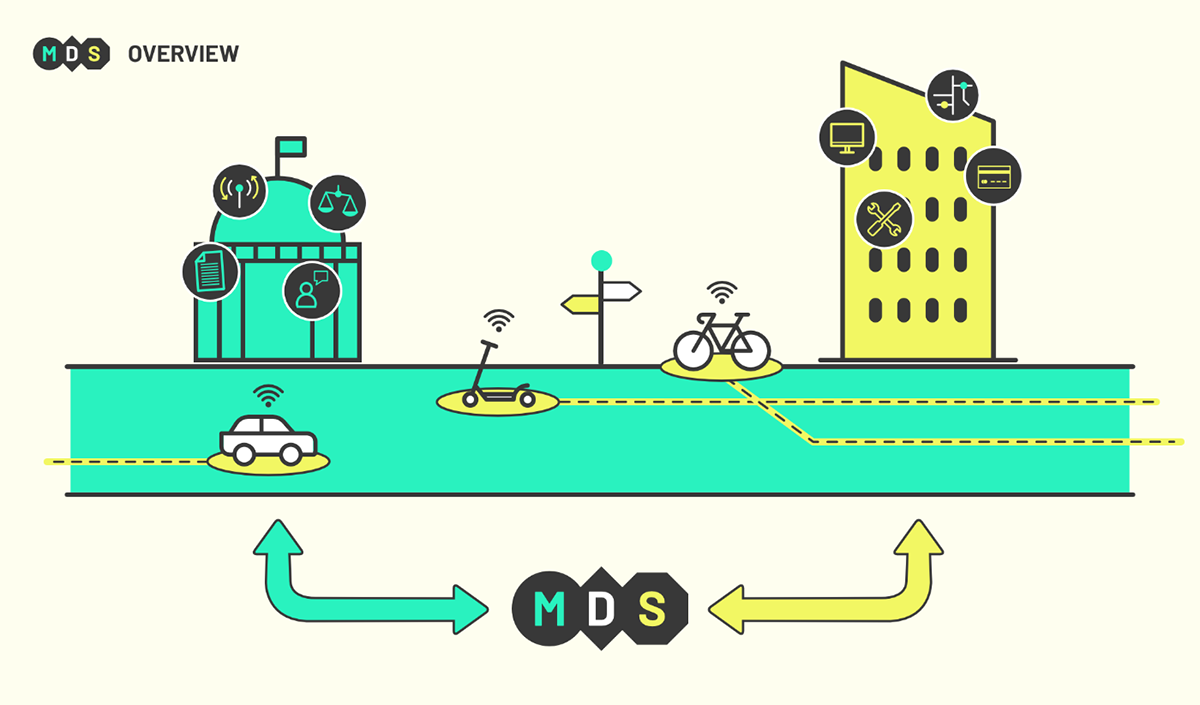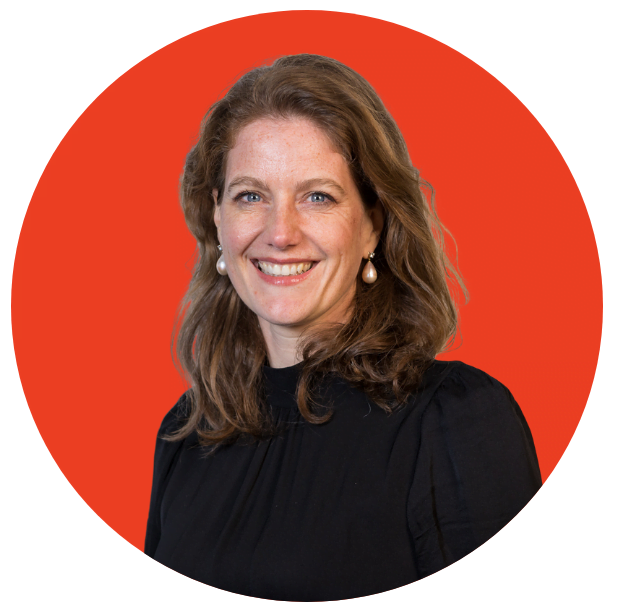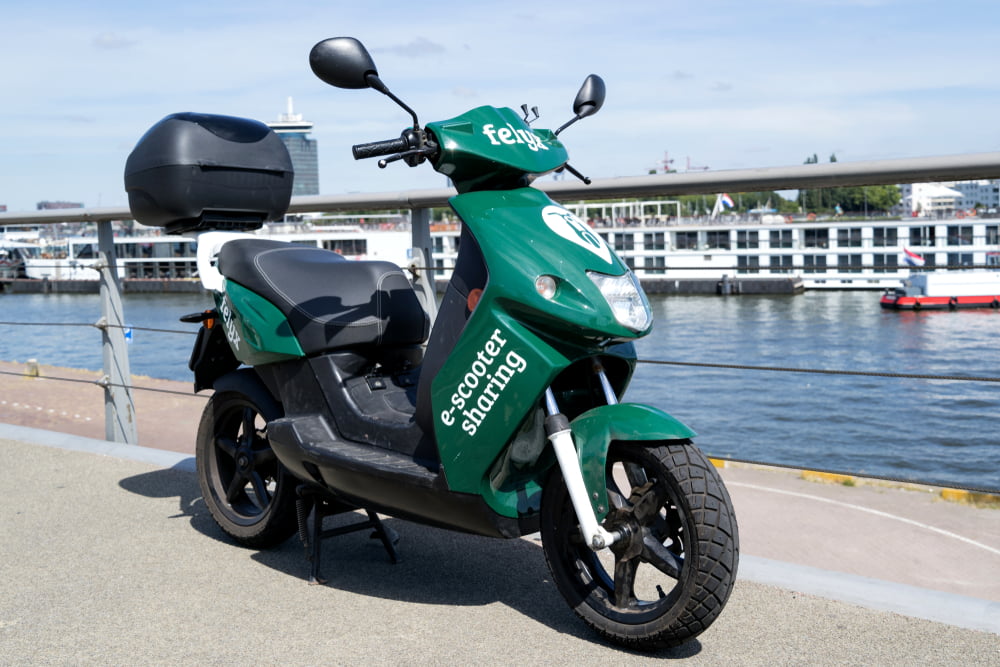A Vision that Spans an Ocean: Digitalised Mobility in the US and Europe
Cities and organisations in the United States and Europe explain their common vision for digitalised mobility, with concerns for efficiency, security, transparency, and standardisation in mind.
From conversations with Andrew Glass Hastings, Connie Llanos, Gemma Schepers, Martin Lefrancq, and Ivo Cré, elaborated by Quaid Cey.
To listen to the recording of the article below, please accept all cookies.
What will the city of tomorrow look like? More and more often, the answer of mobility experts seems the same: cities will digitalise their transport infrastructure. In other words, they will continue to ‘transform elements of the physical world into bytes’ so that digital technologies become an essential component of urban transport, logistics, and day-to-day life. In this transition, concepts like data-sharing, automation, artificial intelligence, and data-oriented decision-making will become increasingly relevant.
But how will communities around the world experience the progress toward digitalised mobility differently? With communities across Europe moving at varying rates toward their version of the ‘smart city’, differences between continents are likely to be just as pronounced.
POLIS reached out to mobility leaders from the US and Europe to learn more about the promises that digitisation holds for tomorrow’s urban transport, as well as the barriers to a truly data-driven mobility system. As it turns out, there is far more that connects than divides them in their development of an efficient, secure, and transparent protocol for mobility digitalisation.
Smart streets and curbs: A lesson from the US
To start things off, POLIS spoke to Andrew Glass Hastings, Executive Director of the Open Mobility Foundation (OMF), a US-based foundation working at the forefront of open-source mobility.

The MDS bridges the gaps between cities and transport operators. Credit: Open Mobility Foundation
A newcomer to the POLIS network, the OMF stands out as a pioneer in the domain of mobility digitalisation. ‘The idea behind the OMF is to convene a public-private set of stakeholders – bringing cities, regional public agencies, and other agencies together with technology companies and mobility operators – to co-create open-source data standards and steward them so that they continue to meet the needs that cities face as transportation continues to digitise,’ Andrew informed POLIS.
Much of the OMF’s work has centred on developing and implementing the Mobility Data Specification (MDS) – a digital tool that enables data-sharing between local authorities and transport providers of all kinds, from e-scooters and bike-sharing companies to public transport operators. Retracing the history of the MDS, Andrew explained: ‘The original focus of MDS was on micromobility – shared bikes and scooters. More recently, with the introduction of MDS 2.0, the MDS includes more modes of shared mobility, such as taxis, car-shares, services like Lyft and Uber, autonomous vehicles and robo-taxi services, and even things like sidewalk delivery robots.’

Andrew Glass Hastings, Executive Director, Open Mobility Foundation
On its website, the OMF publishes a list of case studies showing how the MDS enhances urban transport management and policymaking, such as in infrastructure planning, dynamic pricing for parking, street lighting improvements, digital twinning of preferred parking zones, and car usage reduction analysis. Many of the cities that have deployed the MDS are already experiencing these benefits firsthand. From equitable access improvements to reduced congestion and finer-tuned safety measures, the MDS offers cities new ways to learn from mobility data and develop effective policy responses.
But MDS is not the only project that the OMF has been working on: the organisation has also been active in the rollout of the Curb Data Specification (CDS), a digital tool that helps cities make more efficient and dynamic use of their curb spaces, starting with loading zones. Andrew told POLIS: ‘Public space – curbs, in particular – have been managed by cities for decades, but they have been managed in an analogue format. In stewarding CDS, we are enabling cities to code their curb, so to speak, and to do that in a way that is consistent across cities in North America, Europe, and around the world, so that everyone is doing this in the same language.’

An automated bus navigates narrow city streets. Credit: Suwin, Shutterstock
Thanks to its flexibility, the CDS can help to promote sustainability, safety, and accessibility in various ways. For example, cities can use the CDS to provide real-time data on curb status and analyse curb usage in the long term, both of which help authorities to optimise efficiency and fine-tune their policy objectives. Another application of CDS is the publication of loading zone rules and locations online and in a machine-readable format, something that will become ever more valuable as automated vehicles (AV) are deployed for deliveries.
This is one of the future applications that Andrew is most enthusiastic about: ‘Digital infrastructure can help AVs, which are essentially driving computers, to access all information on curb rules and regulations, even around things like dedicated curb space for AVs for pick-up and drop-off. Thinking about the future, AVs are certainly one of the areas of focus for both the MDS and the CDS,’ he told POLIS.
Starting local: The city that dared to go digital
One of the cities in the US that has been active in the area of digitalised mobility is Los Angeles. Connie Llanos, consultant, strategist, and former Interim General Manager for the Los Angeles Department of Transportation (LADOT), told POLIS: ‘In Los Angeles, we’ve been an epicentre for transport innovation, and we welcomed this as a way to give our more than 4 million residents more choices for how they get to where they need to go.’

Connie Llanos, Former Interim General Manager, Los Angeles Department of Transportation
Since the beginning of the OMF, the City of Los Angeles has played a starring role in the development of new codes and tools essential for digitalised mobility. It was Los Angeles that lent the OMF their open-source code base for a mobility data platform: the MDS.
‘New modes of transportation are nearly impossible to manage when mobility providers are using digital tools and cities are on analogue systems. Digital tools like MDS and CDS give cities a way to say ‘yes’ to innovation without compromising their core responsibility to manage the public right of way,’ Connie explained.

Dockless scooter parked on a Los Angeles sidewalk. Credit: Juliette Contin, Unsplash
Reflecting on the progress that the city has made with digitalised mobility, she added: ‘In LA, MDS provided the tools to manage one of the largest dockless scooter programs in the US, with more than 30,000 permitted vehicles operating on city streets. This has been a great way to provide millions of Angelenos with a cleaner alternative to a single occupancy vehicle, and we were even been able to drive some of that growth into disadvantaged areas of the city that historically had fewer transportation options. Making sure we were meeting safety, equity and accessibility goals was only possible when we had the digital tools to measure and manage fleets.’
Dutch ambition meets shared mobility
On the other side of the Atlantic, one country has taken its reputation for innovation to the next level: the Netherlands is paving the way for safer, more efficient digitalised mobility in Europe.
Building on the work of the OMF in the US, the cities of Amsterdam, Utrecht, Groningen, Eindhoven, and Rotterdam, together with the Dutch Ministry of Infrastructure and Water Management, have developed a (shared) mobility data standard that leverages the advantages and mitigates the risks of mobility data exchange. They’re calling it the CDS-M: City Data Specification – Mobility.

Gemma Schepers, Project Manager Smart Mobility, Gemeente Amsterdam
Gemma Schepers, Smart Mobility Project Manager for the City of Amsterdam, told POLIS why the CDS-M is needed: ‘Transport is becoming smarter and smarter, and data exchange has become an important part of the mobility chain. Municipalities, provinces and the national government request data from mobility providers to monitor, learn, and manage public space. But there is no uniform standard for the exchange of that data: different governments set different requirements for mobility providers. This can be done more effectively and efficiently by developing a single, uniform City Data Specification - Mobility (CDS-M).’
Recognising the many challenges with data-driven mobility, from the hacking of transport systems to breaches of transport users’ privacy, the mobility leaders behind the CDS-M have developed guidelines for safe data management. In their Manual for the Secure Exchange of Shared Mobility Data, they provide a roadmap for other cities to follow as they integrate data-sharing tools into their transport operations.
Like the MDS, the CDS-M is compliant with the General Data Protection Regulation (GDPR), which sets limits on data collection, storage, and processing in the EU. Following one of the foundational principles of the GDPR – data minimisation – the motto of the CDS-M can be summarised in three words: ‘Less is more.’

The Felyx e-scooter: a new way to get around in Amsterdam. Credit: Bjoern Wylezich, Shutterstock
Rather than hoarding data on the off chance that it might prove useful later on, the architects of the CDS-M advocate for a targeted approach. They recommend that cities identify the urban mobility change at hand and then decide – with the experiences and insights of other cities as their North Star – exactly what data they need to tackle each problem effectively. By keeping data collection and sharing to the minimum required, ensuring that data is only used for agreed-upon purposes, and enabling cities to learn from each other, CDS-M allows city leaders to make their transport ecosystem more functional without compromising the trust of their citizens.
Gemma is hopeful that other cities in the Netherlands and around Europe will soon recognise the benefits of secure mobility data management and follow the example set by Amsterdam, Utrecht, Groningen, Eindhoven, and Rotterdam. She explained: ‘Shared mobility is being used in more and more cities as a sustainable alternative to traditional forms of transport. A lot of data is retrieved about the use of shared mobility. This has the advantage that policy can be made based on actual usage, rather than assumptions about it. But sharing data also entails several risks, and that is why it is important that the exchange of shared mobility data is secure, effective and complies with the legal requirements in this area. In practice, the municipalities of Amsterdam, Utrecht, Groningen, Eindhoven and Rotterdam have developed a working method that meets these requirements: CDS-M. This method is publicly available and can be applied to all governments where shared mobility is used.’
Brussels boosts digital governance
Just over 200 kilometres south of Amsterdam, another POLIS Member is making the move toward digitised mobility: Brussels. Brussels Mobility, the regional authority of Brussels-Capital for equipment, infrastructure, and mobility issues, has been active in promoting future-forward transport in and around the city.

Lower traffic flow and safer streets in Brussels: two important goals of Good Move. Credit: François Genon, Unsplash
With their 2020-2030 mobility plan – Good Move – the Brussels Government aims to boost urban life quality and citizen safety by seamlessly integrating different transport modes, making active and shared transport more accessible to all, enhancing the efficiency of public transport, and managing traffic flow in key neighbourhoods. Thanks to strong stakeholder involvement during the design phase of the mobility plan, targeted measures have been adopted with a focus on bringing new, sustainable, and convenient travel options closer to citizens.
Mobility data is an essential component of Good Move, both because it helps to bridge the gaps between administrators, transport providers, and citizens, and because it allows Brussels Mobility to monitor the success of the programme. In particular, the exchange and instrumentalisation of data on shared mobility have proven essential for optimising multimodal traffic management.

Martin Lefrancq, New Mobility Policy Advisor, Brussels Mobility
Martin Lefrancq, New Mobility Policy Advisor at Brussels Mobility, told POLIS: ‘The recent review of regulations for shared micromobility allowed us to dive deep in the digital governance of these services. We approached the problem with these basic principles of mobility data flows in mind: data sharing between stakeholders of the Mobility-as-a-Service (MaaS) ecosystem on the one hand, and data reporting to the authority for planning and enforcement purposes on the other. In addition, we created interoperable digital regulations mirroring the physical ones, so that providers can turn them into reality in their system, hopefully making shared micromobility a reliable and efficiently integrated service in Brussels’ transport offer. And this is just a first step as we are looking to replicate that for other services as well.’
From electric bikes and scooters to shared cars and vans, cargo bikes, and public transport, the Belgian capital continues to expand its mobility offer, with a focus on low-emission, shared, and active transport. By simultaneously moving in the direction of data-driven management, the city can ensure that the new transport modes and technologies are properly accounted for and regulated, in turn making them benefactors rather than deterrents for Brussels’ evolving mobility ecosystem.
Understanding differences and overcoming shared obstacles
Based on the experiences of the OMF and the cities of Los Angeles, Amsterdam, and Brussels, it appears that mobility leaders in the US and Europe share a common vision for digitalised mobility and an understanding of the advantages it offers. As Gemma Schepers told POLIS: ‘There are a lot of similarities between the European and American cities. All cities need data to get better insights into traffic flows in cities, and we all work in bureaucratic organisations. The use cases and problem questions that cities have are very universal.’
While their objectives may be similar, there are key contextual differences — mainly regulatory — that bear noting. Andrew Glass Hastings reminded POLIS that ‘because the US has been left to a very decentralised, fragmented approach, without a national framework or strategy around data and digital infrastructure, it’s really hard to avoid the proprietary nature of technology players, who in the US tend to develop a technology and keep it in their black box.’
‘Because of the policy guidance and the policy position of the EU,’ he added, ‘I see much less of that happening, which will ultimately serve the interests of cities and the public as we continue along this trend of mobility digitisation.’
While Europe’s data privacy regulations could be a boon for mobility digitalisation, readiness to pursue new and unfamiliar methods of urban management may be lower amongst European leaders.

Ivo Cré, Director of Policy and Projects and Coordinator Access Working Group, POLIS
According to Ivo Cré, Director of Policy and Projects and Coordinator of the Access Working Group at POLIS, Europe’s progress toward dynamic curbside management (DCM) is a case in point: ‘Europe is slowly discovering the potential of curbside management, and initial experiences are being established in POLIS-involved European Research and Innovation projects, such as DISCO. The situation in Europe, however, is different from that of the US. It remains difficult for European cities to leave the stable parking system – with its procedures, regulations, and associated revenue – aside in favour of dynamic space use involving different stakeholders and service and business models. I am convinced that Europe’s cities will make the switch, but that it will be a different – a European – approach.’ These differences point to some of the obstacles standing in the way of data-driven mobility, which cities in the US and Europe experience to varying degrees.
One of the most glaring issues, Andrew notes, is capacity-building for local governments: ‘If we want to put government and technology on equal footing,’ he commented, ‘we need to be able to resource local government actors so that they know how to do so. We need to build the workforce not just so that technology companies can continue to innovate, but also for the local government teams to be able to partner up and manage this digital transformation.’
Gemma pointed out that this a problem not only in the US but also on the other side of the pond: ‘The majority of our civil servants don’t always have the time and capacity to organise all that is needed to work with data. Every city is trying to reinvent the wheel, which costs lots of time. That is why the Netherlands decided to make the ‘Dutch Profile’ – a means for all cities and mobility providers to work in the same way when it comes to data exchange – to relieve civil servants of some of their work. This is what we should organize in Europe.’

Responsible digitisation brings mobility closer to citizens. Credit: A_B_C, Shutterstock
Andrew also highlighted another, related issue, and one that must be addressed if cities in the US and Europe are to deploy tools like the MDS, CDS, and CDS-M sustainably: citizen mistrust.
‘None of this can be done in a vacuum,’ he told POLIS. ‘One of the aspects of capacity-building for local governments that are most critical is making sure that the public understands what is happening and how they can benefit from it, and that it’s not an experiment on them but something that will make it safer, healthier, and easier to move around their communities. It’s not enough for the government to be talking to itself or talking to technology partners: we’ve got to relate this to the average person on the street.’
Conclusions
Though they find themselves on opposite sides of the ocean, one goal sits close to home for mobility leaders in both the US and Europe: implementing a standardised toolkit for digitalised mobility that balances efficiency, security, and transparency.
With standardised, GDPR-compliant tools that bridge the gaps between local authorities and service providers while meeting the needs of citizens, cities in the US and Europe strive to optimise traffic management and use of public space.
What remains to be seen is whether their ocean-spanning ambition can hold ground in the rest of Europe, and what new challenges and solutions might arise as digitalised mobility advances.
Click here to read the article in its original format.
About the contributors:
Interviewee: Andrew Glass Hastings is the Executive Director of the Open Mobility Foundation. He has extensive experience working at the intersection of the public and private sectors. He leads a unique public/private partnership, through which cities and companies collaborate in real-time to produce the open-source data standards and software tools that cities need to digitise their infrastructure and manage all forms of mobility.
Interviewee: Connie Llanos recently served as Interim General Manager for the Los Angeles Department of Transportation, where she led initiatives on pandemic response, Olympics planning, and transport innovation. She has experience working at the intersection of strategy, communications, and policy. A former journalist and strategist for elected officials and Fortune 500 companies, she now leads Cielo Strategic Communications.
Interviewee: Gemma Schepers is a Smart Mobility Project Manager for the City of Amsterdam’s Innovation Office (CTO). Together with the CTO team, she manages short-term experiments in living labs that involve citizens and the private sector. Currently, she is focused on smart mobility and the digital transition, with an emphasis on cyber security, secure data exchange, and privacy.
Interviewee: Martin Lefrancq is the New Mobility Policy Advisor at Brussels Mobility. He is involved in all things shared-, micro-, and e-mobility, as well as Mobility-as-a-Service (MaaS) policy. Currently, he is working on a comprehensive regulatory framework and data governance for the Brussels’ MaaS ecosystem to facilitate innovative mobility solutions and a more efficient transport system.
Interviewee: Ivo Cré is the Director of Policy and Projects at POLIS. He is active in EU research and innovation projects and advocacy relating to EU urban mobility research and innovation, TEN-T, SUMP, public transport, access regulations, parking, and digitalisation in each of these areas. He also leads the POLIS Working Groups on Access and Parking.
Interviewer: Quaid Cey is a Communications Assistant at POLIS. His responsibilities include producing news and social media content, promoting POLIS events and campaigns, and contributing to the publication of Cities in motion. He has a BA in Liberal Arts & Sciences from the University of Maastricht (UM) and an MA in Communication Studies from the Vrije Universiteit Brussel (VUB).
